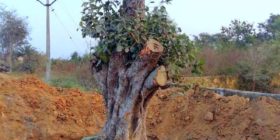A small change in the Supreme Court’s paper usage could save enough water to provide for 12 million people.
As many as 61,520 cases were filed in the Supreme Court between October 2016 and September 2017, and using paper printed on both sides in filings would have saved nearly 2,953 trees and 246 million litre water (24,600 tankers–considering one standard tanker-truck holds 10,000 litre), according to an analysis by the Centre for Accountability and Systemic Change (CASC), a New Delhi-based think tank.
A public interest litigation (PIL) was filed in the Supreme Court by CASC on Sept. 5, 2018, seeking directions to use paper printed on both sides in pleadings and filings before the apex court.
Another PIL, filed on Aug. 8, 2018, in the Delhi High Court by CASC–with the above objective–said using paper printed on both sides would have saved over 27,000 trees and 2,000 million litre water based on the number of cases filed in one month before the subordinate courts and high courts across the country.
The petitions highlight large-scale paper consumption — double-spaced typing and wide margins — in courts. “Using line spacing as 1.5 instead of 2 causes 25 percent savings of paper. Similarly, using smaller fonts cause 30 percent savings of paper,” the petitions said.
Courts use paper printed on one side because of official formats and a tradition that dates to the years of typewriters, which are still used in many courts.
How Paper Printed On Both Sides In Courts Can Save Resources.
A tree produces 8,333 sheets of virgin–non-recycled–paper while it takes 10 litres (2.6 gallons) of water to create a piece of paper, says a 2010 paper by Ruth Anne Robbins, Conserving the Canvas: Reducing the Environmental Footprint of Legal Briefs by Re-imagining Court Rules and Document Design Strategies.
Considering 61,520 cases in the Supreme Court with only two parties per case, eight sets of files would be required — four for the court and one each for the parties and their counsel. If each petition is of 100 pages, a minimum of 49.2 million papers would be required.
This means, 5,906 trees would have been used to make 49.2 million sheets of paper. So, using paper printed on both sides would have saved 2,953 trees and 246 million litre of water.
The amount of water saved could provide 12 million people–the population of Bengaluru, a city that may run out of water in 12 years–their basic water requirement of 20 litre per day for cooking and drinking.
Bengaluru is supplied 100 litre water per person per day of which only 20 litre is used for cooking, drinking and bathing purposes. The rest 80 litre is used for non-potable purposes like cleaning floors, flushing toilets and washing cars.
India is projected to fall 50 percent short of fresh water needs by 2030, according to this 2010 study by the Asian Development Bank.
“Paper products make up the largest component of municipal solid waste,” the petitions said.




Leave a reply